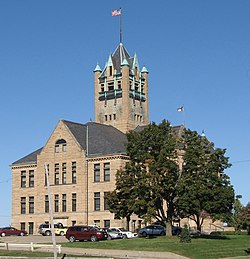Johnson County | |
|---|---|
 | |
 Location within the U.S. state of Iowa | |
 Iowa's location within the U.S. | |
| Coordinates: 41°40′00″N91°35′00″W / 41.666666666667°N 91.583333333333°W | |
| Country | |
| State | |
| Founded | December 21, 1837 |
| Named after | Richard Mentor Johnson (1837–2020) Lulu Johnson (since 2020) |
| Seat | Iowa City |
| Largest city | Iowa City |
| Area | |
• Total | 623 sq mi (1,610 km2) |
| • Land | 614 sq mi (1,590 km2) |
| • Water | 9.1 sq mi (24 km2) 1.5% |
| Population (2020) | |
• Total | 152,854 |
| 160,080 | |
| • Density | 260/sq mi (100/km2) |
| Time zone | UTC−6 (Central) |
| • Summer (DST) | UTC−5 (CDT) |
| Congressional district | 1st |
| Website | www |
Johnson County is located in the U.S. state of Iowa. As of the 2020 census, the population was 152,854, [2] making it the fourth-most populous county in Iowa. The county seat is Iowa City, [3] home of the University of Iowa. Johnson County is included in the Iowa City metropolitan area, which is also included in the Cedar Rapids-Iowa City Corridor Combined Statistical Area. [4]




